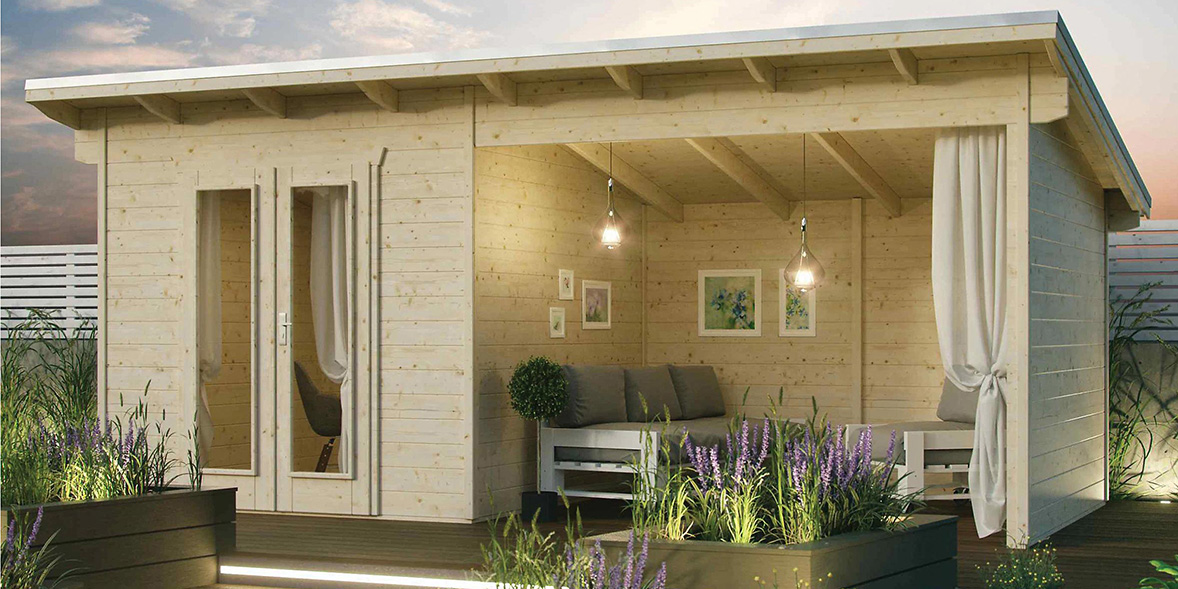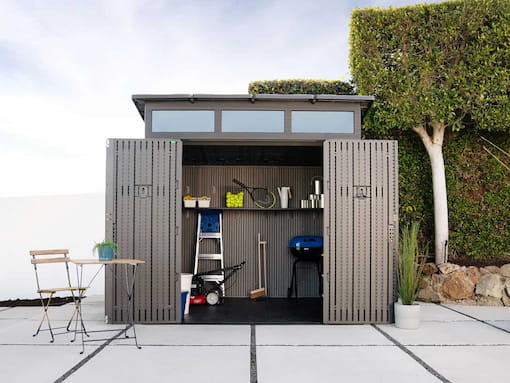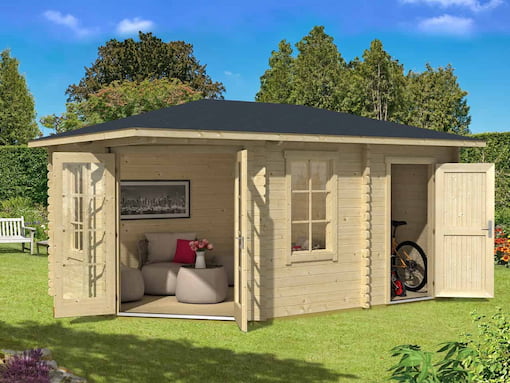
Whether as a tool shed, hobby room or as a retreat for reading and lingering – garden houses have versatile uses. Durable and weatherproof, the garden house should be and at the same time a visual eye-catcher in the garden. Depending on how you want your dream garden house to look and how you want to use it in the future, not only the footprint and shape of the garden house should be chosen carefully. The shape of the roof can also be an important factor. Our guide answers the following questions: what roof shapes are there for garden houses, what is the ideal roof shape for my garden house and what to consider when choosing?
What roof shapes are there for garden houses?
Whether a classic pent roof, a modern flat roof or an unusual pagoda roof – the ideal roof shape for a summer house can be found for every taste and every requirement:
Gable roof
The gable roof is the classic among the roof forms: It consists of two pointed roof surfaces facing each other and straight gable walls. Rainwater flows off to the sides. Depending on the roof pitch and eaves height, additional storage space and usable area are created under the roof.

Pent roof
The pent roof is a very popular and inexpensive roof form for garden houses. It is characterized above all by a simple, classic look. The roof consists of a single sloping surface. The slope here can be chosen in different degrees. As a rule, however, it is relatively low, and a roof pitch of 7° is sufficient for rainwater to drain off reliably. A particularly practical feature is that monopitch roofs are suitable for the installation of solar systems.
Hip roof
The hipped roof is more or less a gable roof, but with this roof shape the gables are also sloped. This creates a certain symmetry and makes for a sleek, visually appealing look.
Flat roof
The flat roof has a very low roof pitch of only 3-10°. This ensures that rainwater runs off and does not collect on the roof. However, the slope is so inconspicuously low that the roof appears flat. This roof shape ensures the greatest possible usable space in the garden house and stands for a clear, straightforward look.
Barrel roof
The barrel roof is a round variation of the classic gable roof. The cylindrical shape of the roof gives the summerhouse an almost historic look while allowing rainwater to drain away easily.
Lifetime MerkurLifetime Merkur
Tent roof
This is a variation of the hipped roof: the roof surfaces of the tent roof run towards each other like a pyramid. Different roof pitches can further emphasize the special look of this roof shape.
Stepped roof
The stepped roof is certainly a very special, eye-catching roof shape. It consists of two separate, offset roof slopes. These can have the same roof shape, or they can be different – depending on the desired look. The two roof planes are, in turn, separated by a vertical front. Often this is enhanced with small windows, which provides an additional source of light.
Pagoda roof
The pagoda roof is also one of the more striking roof shapes and gives the garden house a Far Eastern look. The initial shape here is a hipped roof, on which, in turn, a smaller hipped roof is placed. Small windows provide additional light into the interior of the garden house.
In the following table we have summarized for you the advantages and disadvantages of each type of roof:
| Roof shape | Advantages | Disadvantages |
|---|---|---|
| Gable roof | Variable roof pitch: Sloping roof surfaces drain rain well, flat ones allow snow to slide off well Roof extension provides additional usable space under the roof Many design options, e.g. with additional windows in the gable Simple, inexpensive roof shape Roof slopes can be pulled over the garden house as an overhang | Limited design options, e.g. by adding more windows Limited usable space for particularly steep gable roofs |
| Pent roof | Simple, cost-effective roof shape With a flat roof pitch: Greening & installation of solar panels possible Alignment to the weather side allows rain to drain off well & reliably protects the garden house from the elements Tilt roof design: Allows for overhang and additional usable space | Increased maintenance due to low roof pitch: Branches & leaves must be removed from the roof regularly If the roof pitch is too low, there may be a risk of water damage due to rainwater penetration |
| Hipped roof | Depending on the roof pitch very tapered, therefore ideal for tall people | No gable, therefore limited expansion possibilities in the interior space |
| Flat roof | Maximum usable space in the garden house Low weight of the roof structure Roof greening & installation of solar panels possible Rainwater still drains reliably Possibility to build an overhang. | Not suitable for snowy regions: Snow cannot slide off due to the low roof pitch Increased maintenance due to low roof pitch: Branches & leaves need to be removed from the roof regularly |
| Barrel roof | No roof slopes :interior space can be used optimally Greening of the roof area possible | Installation of solar modules is not possible Heat bridges can occur |
| Tent roof | Basic shape can be freely chosen (often hexagonal or octagonal):Ideal for all weather conditions. | With a very low roof pitch, snow & rain cannot slide/run off ideally A flat tent roof does not provide expansion possibilities for the interior space |
| Stepped roof | Gable areas allow installation of additional windows Roof conversion possible for additional usable space Free design options for roof shapes | Cost-intensive construction method, as reliable sealing is very complex due to the offset roofs |
| Pagoda roof | Special optics Additional light incidence through extra window | Costly |
Make the right choice
Which roof shape is ideal for your garden shed depends on several factors:
Personal taste
Personal taste is definitely the most decisive criterion when choosing the roof shape of the garden house, because the garden house should be visually appealing and perfectly fit into the surrounding garden design. A garden house is always an extension of the home into the outdoor area. Therefore, for some homeowners, it is certainly important that the garden house visually matches the residential house.
Lasita Maja Aruba hip roof

How will the garden house be used in the future?
The future use of the garden house should also be considered when choosing the roof shape: Do I want to use the garden shed only for storing garden tools and furniture? Or should it serve as an additional living space, possibly even with a second level as an overnight accommodation?
Depending on the application, some roof shapes are particularly well suited or not at all: A monopitch roof, for example, offers hardly any expansion possibilities for the interior. A gable roof, on the other hand, can be varied very easily in terms of roof pitch and thus offers a wide range of options for interior expansion.
In which region do I live?
Another factor that should not be neglected when choosing a suitable roof shape is certainly the region in which you live. What are the weather conditions there? Does it rain often and in large quantities? Is frequent snowfall the norm?
Again, some roof shapes are more or less suitable: roofs with a low pitch tend to be unsuitable in regions with a lot of snowfall, as the snow cannot slide off reliably. The roof is overloaded and in the worst case even threatens to collapse. The same applies to rain: a higher roof pitch always ensures that rain drains off reliably. In addition, in rainy regions, special care or additional waterproofing may be required to ensure that the garden shed remains watertight. By choosing a suitable roof for your garden shed, you thus contribute to its weather resistance and longevity.
As with any building project, local building codes apply to garden sheds. It is therefore essential to find out from the relevant building authority whether you need a building permit for your garden shed and which regulations you must comply with. It is also possible, for example, that a certain roof pitch is prescribed. This limits the choice of garden house model and roof shape.
Frequently asked questions
Here you will find answers to questions that we are often asked.
Which roof for garden house?
Which roof shape is right for your garden house depends on your own taste. Do you prefer it plain? Or do you want it to be trendy or particularly eye-catching? For many homeowners, it is also important that the garden house visually matches the home and the rest of the garden design.
The future use of the garden house also has an influence on the decision as to which roof shape is suitable: should your garden house only serve to store garden tools and furniture, or do you want additional living space with a possible roof extension? In addition, the weather conditions of the region should be taken into account: Reliable rain drainage should be ensured in rainy regions by a sufficient roof pitch. The same applies to the problem-free sliding of snow in regions with heavy and frequent snowfall. The good news is that many models are now available in a wide range of variants with different roof shapes and pitches, so they can be customized to suit your wishes and requirements. So you can find the ideal solution for your requirements.
Which roof pitch for the garden shed?
The roof pitch not only influences the appearance of the garden shed, but also ensures that rain and snow can reliably run off and slide down. Our recommendation: Choose a minimum roof pitch of 3°. Be sure to observe the specifications of the local building authority. In some places, a roof pitch of at least 7° may be prescribed. Other municipalities, however, give builders free rein.

